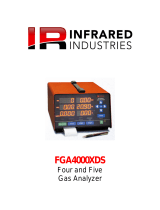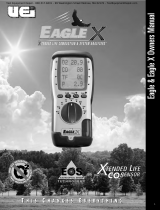
Instruction 24-9448
ii
Contents
4 Operation . . . . . . . . . . . . . . . . . . . . . . . . . . . . . . . . . . . . 4-1
4.1 Operating Tips . . . . . . . . . . . . . . . . . . . . . . . . . . . . . . . . . . . . . . . . .4-1
4.2 Turning ON the Analyzer and Warm Up . . . . . . . . . . . . . . . . . . .4-2
4.3 Selecting a Fuel . . . . . . . . . . . . . . . . . . . . . . . . . . . . . . . . . . . . . . . 4-3
4.4 Sampling Point . . . . . . . . . . . . . . . . . . . . . . . . . . . . . . . . . . . . . . . 4-4
4.5 Performing a Combustion Test . . . . . . . . . . . . . . . . . . . . . . . . . . . 4-5
4.6 Making a Draft / Pressure Measurement . . . . . . . . . . . . . . . . . . .4-7
4.7 Saving Test Data . . . . . . . . . . . . . . . . . . . . . . . . . . . . . . . . . . . . . . 4-8
4.8 Ending a Combustion Test . . . . . . . . . . . . . . . . . . . . . . . . . . . . . . 4-9
4.9 Emptying the Water Trap . . . . . . . . . . . . . . . . . . . . . . . . . . . . . . . 4-9
4.10 Turning OFF the Analyzer & Purging. . . . . . . . . . . . . . . . . . . .4-10
4.11 Low Battery Alarm . . . . . . . . . . . . . . . . . . . . . . . . . . . . . . . . . . .4-10
4.12 Data Logging . . . . . . . . . . . . . . . . . . . . . . . . . . . . . . . . . . . . . . . .4-11
4.12.1 Turning ON Data Logging . . . . . . . . . . . . . . . . . . . . . . . .4-12
4.12.2 Setting the Logging Interval and Duration . . . . . . . . . .4-13
4.12.3 Starting the Data Logging Process . . . . . . . . . . . . . . . . .4-14
4.12.4 Ending the Data Logging Process . . . . . . . . . . . . . . . . . .4-15
4.13 Memory . . . . . . . . . . . . . . . . . . . . . . . . . . . . . . . . . . . . . . . . . . . .4-15
4.13.1 Recalling Combustion Test Data . . . . . . . . . . . . . . . . . . .4-16
4.13.2 Recalling Logged Test Data . . . . . . . . . . . . . . . . . . . . . . .4-17
4.13.3 Clearing Memory . . . . . . . . . . . . . . . . . . . . . . . . . . . . . . .4-18
4.14 Downloading Stored Data to a Computer . . . . . . . . . . . . . . . . . .4-19
4.14.1 PCA 2 Data Recovery Program Installation . . . . . . . . . 4-20
4.14.2 Computer to PCA 2 Connection & USB Device Driver In-
stallation . . . . . . . . . . . . . . . . . . . . . . . . . . . . . . . . . . . . . . . . . . . 4-22
4.14.3 Recovering Data . . . . . . . . . . . . . . . . . . . . . . . . . . . . . . . 4-24
4.14.4 Unplugging the USB Cable . . . . . . . . . . . . . . . . . . . . . . . .4-27
4.15 Importing Saved Data Into a Spreadsheet . . . . . . . . . . . . . . . . . .4-28
4.16 Printing Test Data . . . . . . . . . . . . . . . . . . . . . . . . . . . . . . . . . . . 4-30
5 Calibration . . . . . . . . . . . . . . . . . . . . . . . . . . . . . . . . . . . 5-1
5.1 Smart Sensors . . . . . . . . . . . . . . . . . . . . . . . . . . . . . . . . . . . . . . . . .5-1
5.2 Starting a Calibration . . . . . . . . . . . . . . . . . . . . . . . . . . . . . . . . . . .5-1
5.3 Pressure Sensor Calibration . . . . . . . . . . . . . . . . . . . . . . . . . . . . . 5-2
5.4 T-Stack Calibration . . . . . . . . . . . . . . . . . . . . . . . . . . . . . . . . . . . . 5-4
5.5 T-Air Calibration . . . . . . . . . . . . . . . . . . . . . . . . . . . . . . . . . . . . . . 5-6
5.6 CO-LO Sensor Calibration . . . . . . . . . . . . . . . . . . . . . . . . . . . . . . 5-8
5.7 SO
2
Sensor Calibration . . . . . . . . . . . . . . . . . . . . . . . . . . . . . . . . .5-10
5.8 NO Sensor Calibration . . . . . . . . . . . . . . . . . . . . . . . . . . . . . . . . .5-11
5.9 NO
2
Sensor Calibration . . . . . . . . . . . . . . . . . . . . . . . . . . . . . . . . .5-12
5.10 CO-HI Sensor Calibration . . . . . . . . . . . . . . . . . . . . . . . . . . . . . .5-13

























